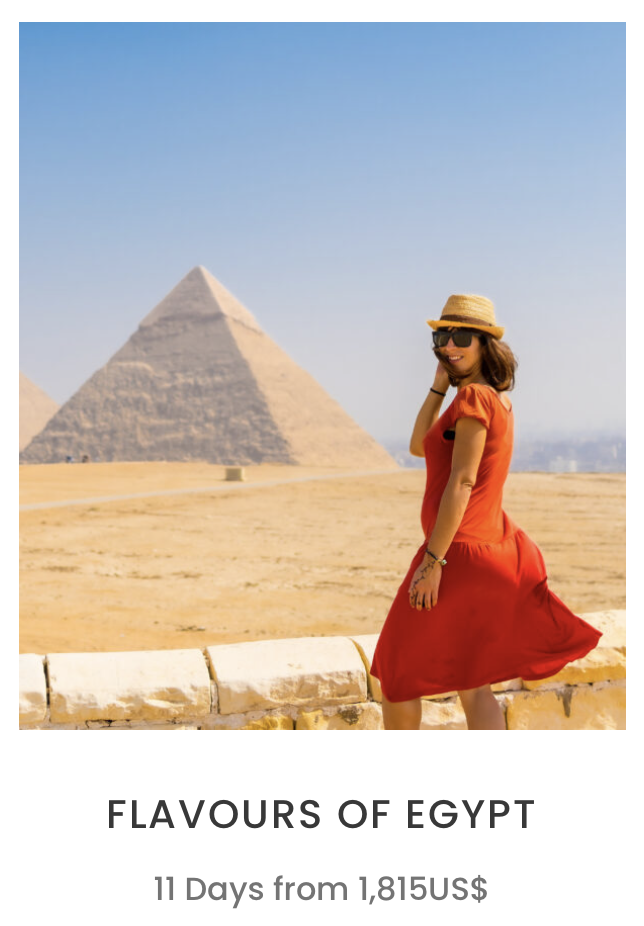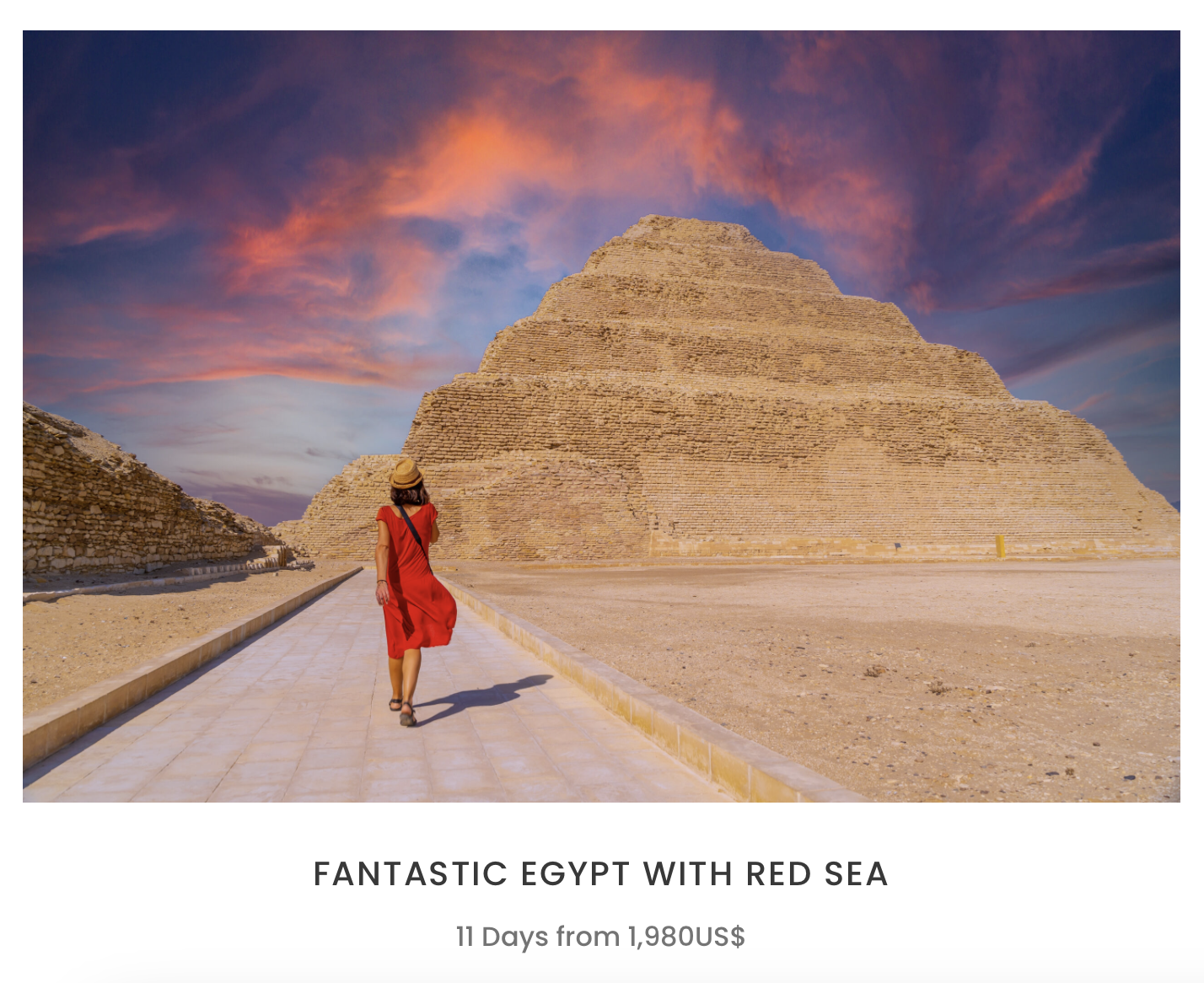Best Guided Trips to Egypt
Egypt, a land where time seems to stand still, gracefully straddles the crossroads between past and present, merging ancient legacies with vibrant modernity. It beckons travelers with tales of bygone dynasties, immortal structures that defy the ages, and heritage as vast and deep as the sands that stretch endlessly across its arid deserts. With coastlines caressed by the azure waters of the Mediterranean to the north and the golden dunes of the Sahara sprawling to the west, this nation is a testament to millennia of civilization and resilience. Woven into its very fabric are stories of pharaohs, warriors, traders, and explorers. As the Nile, its lifeblood, meanders through valleys and ancient settlements, it binds the tales of these cities and their people. In this article, we embark on a journey, navigating through stories and landscapes, as we delve deeper into six cities that not only capture the essence of Egypt but also form the bedrock of its enduring allure.
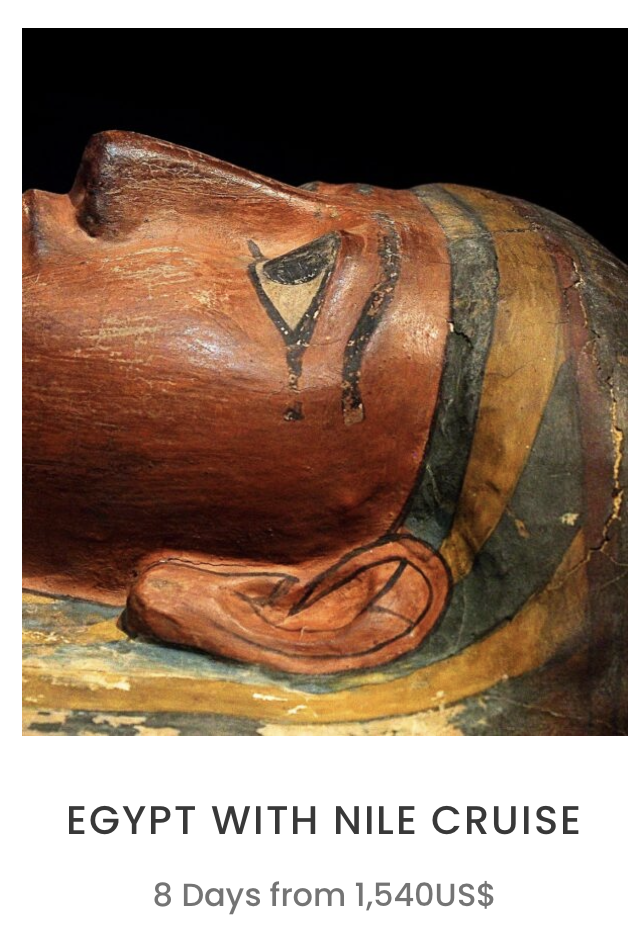 Cairo: Gateway to the Land of the Pharaohs
Cairo: Gateway to the Land of the Pharaohs
Nestled on the fertile banks of the majestic Nile, Cairo stands as a testament to Egypt’s ability to seamlessly marry the ancient with the contemporary. This sprawling metropolis, the beating heart of the country, encapsulates millennia of history and progress within its city limits.
The first sight that often captures a visitor’s imagination is the unfaltering silhouette of the iconic Pyramids of Giza. These colossal edifices, which have loomed large over the desert landscape for over 4,500 years, epitomize the architectural prowess and ambition of ancient Egypt. Adjacent to these pyramids stands the enigmatic Sphinx, its stoic gaze having witnessed the ebb and flow of countless dynasties, foreign invaders, and the relentless march of time.

However, the tales of Cairo are not solely confined to these monumental structures. The Egyptian Museum is an essential chapter in the narrative of this city. A veritable treasure trove, this museum houses the world’s most extensive collection of pharaonic antiquities. From the ornate jewelry of royal courtesans to the intricately designed coffins and the unparalleled treasures of the boy-king Tutankhamun, the museum offers a captivating journey through the epochs of Egyptian history. Each artifact, meticulously curated and displayed, paints a vivid picture of a civilization that once was the epitome of grandeur and sophistication.
But Cairo isn’t just a monument to the past. It pulsates with the vibrancy of the present. The city’s streets are alive, teeming with a blend of traditional and modern culture. Meandering through its labyrinthine alleys, one can hear the melodious calls to prayer intertwining with the cacophony of street vendors and the distant hum of traffic.
The Khan El Khalili market, a relic from the Fatimid era, is the epitome of this sensory overload. A mecca for shoppers and curious travelers alike, its narrow streets are lined with stalls offering everything from intricate silverware and handmade perfumes to vibrant textiles and traditional Egyptian delicacies. The aroma of freshly brewed mint tea wafts through the air, drawing visitors into dimly lit cafes, where tales of old are exchanged over shisha and card games.
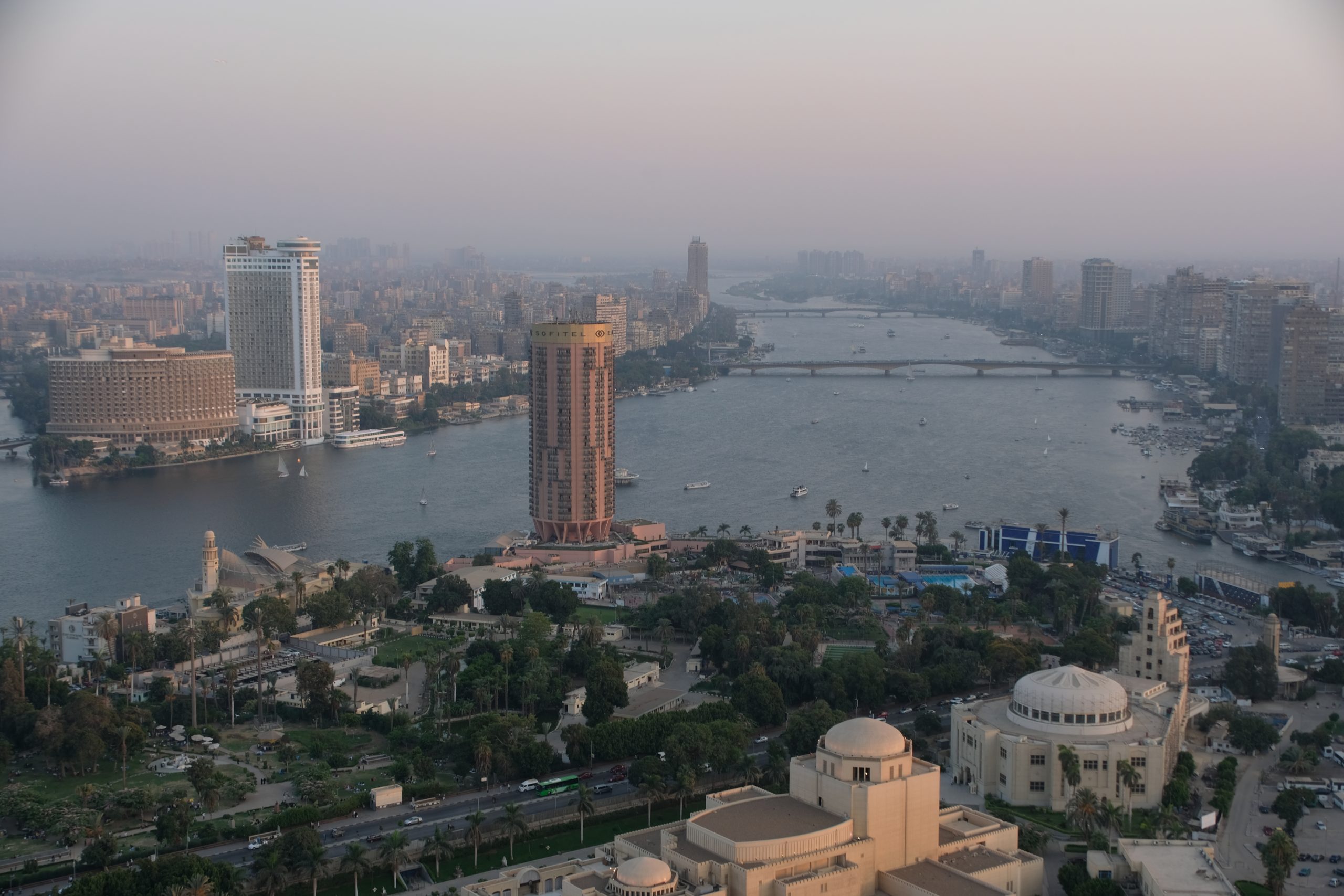
Every corner of Cairo, from its grand mosques and historic Coptic churches to its modern skyscrapers and lush gardens along the Nile, tells a story. It’s a city that invites you to lose yourself in its tales, to wander its streets, and to immerse yourself in its rich tapestry of history and culture.
Luxor: The World’s Largest Open-Air Museum
Emerging from the annals of history and located on the east bank of the Nile, Luxor, with its sun-kissed monuments and temples, stands as a magnificent sentinel to Egypt’s rich and illustrious past. Previously recognized by its ancient name, Thebes, this city was once the thriving capital of the New Kingdom of Egypt, a period marked by prosperity, architectural marvels, and indomitable Pharaonic rule.
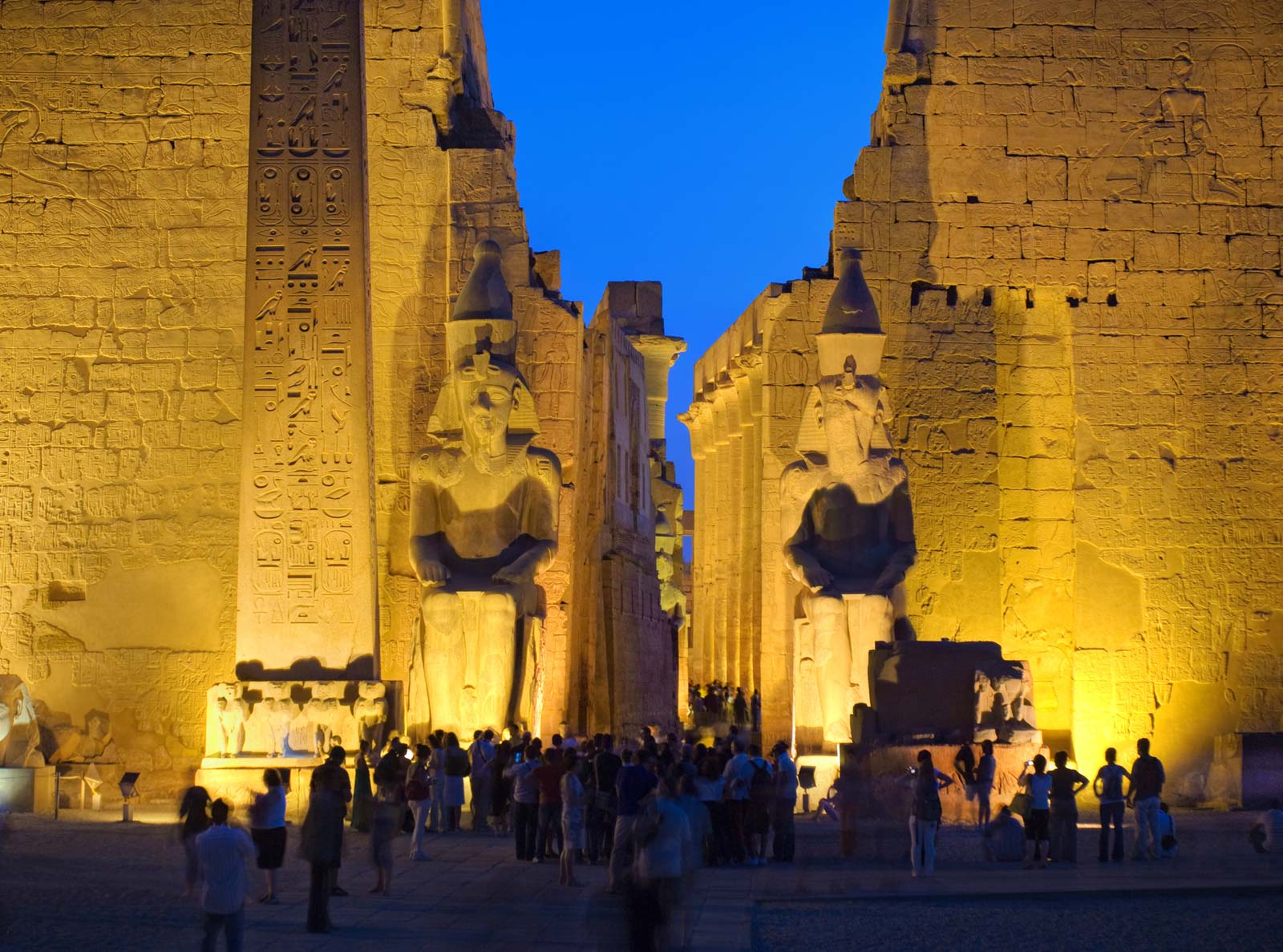
Central to Luxor’s myriad attractions is the awe-inspiring Temple of Karnak. This architectural behemoth, one of the largest religious complexes globally, sprawls across a vast expanse, dwarfing visitors with its monumental columns, intricately carved walls, and colossal statues of deities and pharaohs. The sheer scale of this temple, with its towering obelisks, vast sacred lake, and massive scarabs, reveals the grandiosity of ancient Egyptian craftsmanship and religious fervor. As you traverse its hypostyle hall, with 134 colossal columns, it’s easy to feel the reverberations of ancient ceremonies, the hypnotic rhythms of age-old chants, and the fervent prayers dedicated to the pantheon of gods such as Amun-Ra, the king of gods.
Yet, Luxor’s tales don’t end here. A short journey across to the city’s west bank transports visitors to the mystical Valley of the Kings. This secluded necropolis, etched into the heart of barren mountains, is the eternal resting place of Egypt’s most iconic rulers. For nearly 500 years, this valley was the chosen burial ground for pharaohs, queens, and high priests, who believed that its proximity to the horizon would ensure a swift journey into the afterlife. As you step into the cool confines of each tomb, you are greeted by a riot of colors and hieroglyphics, each chronicling the life, achievements, and beliefs of its occupant. From the intricate frescoes in the tomb of Ramses II, depicting his military triumphs and relationships with deities, to the comparatively modest but world-renowned tomb of the young pharaoh Tutankhamun, laden with treasures and his golden death mask, the Valley offers a poignant glimpse into the aspirations, achievements, and spiritual quests of those who once ruled this land.

In essence, Luxor is not just a city but a living museum, where every stone, statue, and mural narrates tales of ambition, devotion, and the eternal quest for immortality.
Edfu: Chronicles Etched in Stone
– Flavours of Egypt – Positioned between the modern urban sprawl and the time-worn trails of ancient Egypt lies Edfu, a city that whispers tales of gods, conflicts, and enduring devotion. As you approach this historic settlement, the monumental façade of the Temple of Edfu beckons, its majestic sandstone walls casting a formidable shadow on the tranquil waters of the Nile below.
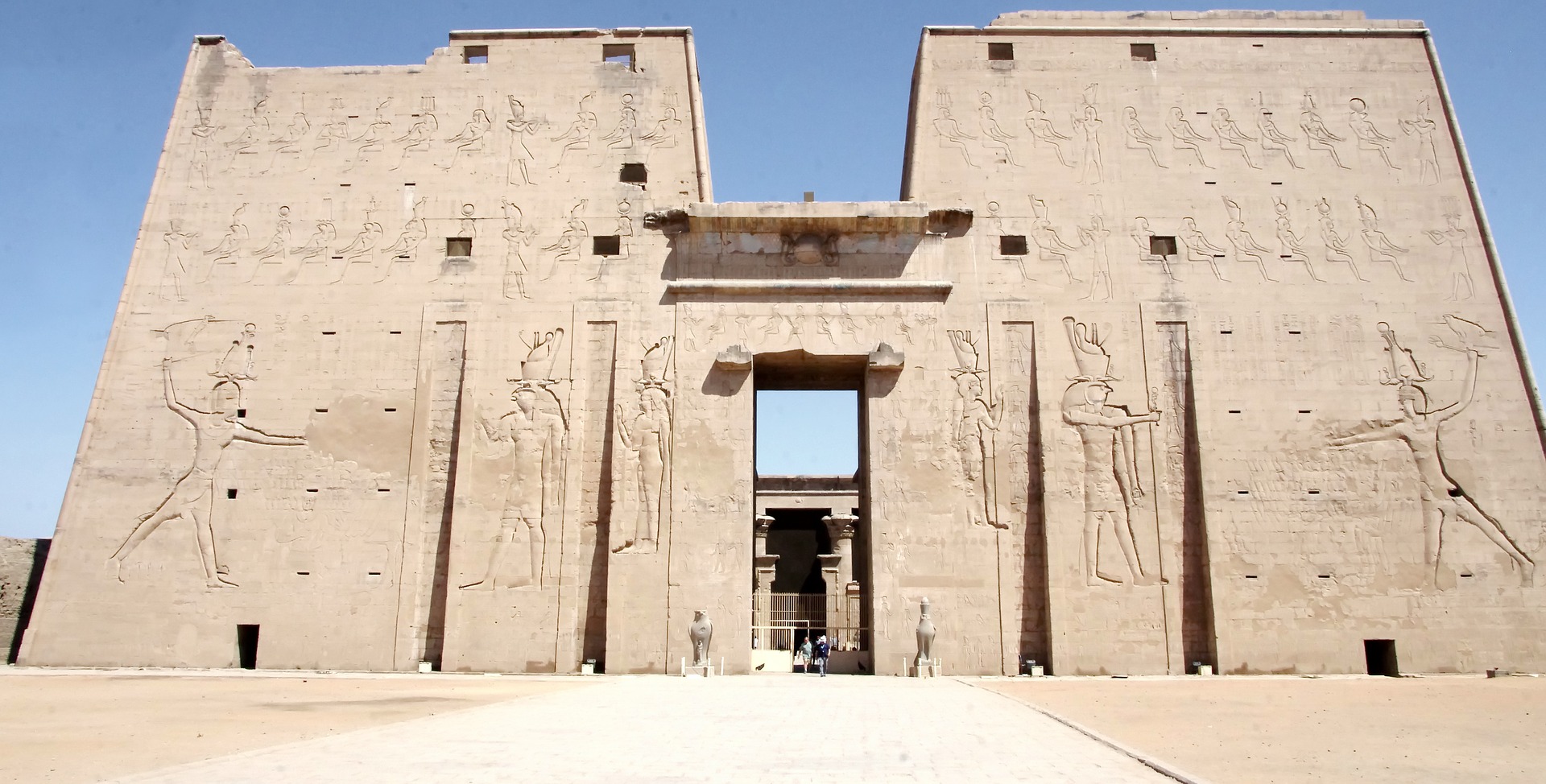
The temple, a magnificent testament to the architectural ingenuity and religious piety of the Ptolemaic era, is arguably one of the most well-preserved shrines in all of Egypt, if not the world. Its significance isn’t just architectural; the temple serves as an indelible link between humanity and the pantheon of ancient Egyptian gods.
Dedicated to the falcon-headed deity, Horus, the Temple of Edfu is a sprawling complex that offers more than just grand columns and intricate carvings. As one navigates the inner sanctums and vast courtyards of this sacred edifice, the walls come alive, recounting an epic celestial battle that has captivated the imagination of scholars, historians, and enthusiasts for generations.
The inscriptions and reliefs meticulously etched into the temple’s walls narrate the enthralling saga of Horus’s vengeance against his treacherous uncle, Seth, who was responsible for the malevolent murder of his father, Osiris. This age-old feud, which resonates with themes of betrayal, resurrection, and redemption, is depicted in painstaking detail. Scenes of fierce combat, divine interventions, and ultimate justice unfold across the stone, allowing visitors to piece together not just the story itself but the very ethos and values that underpinned ancient Egyptian theology and worldview.
Beyond the central narrative, the temple is also a treasure trove of information about rituals, ceremonies, and daily worship practices. Rooms dedicated to specific rituals, such as the offering of gifts to Horus, showcase the meticulous processes and ceremonies that were integral to ensuring divine favor and balance in the world. These chambers, with their bas-reliefs and hieroglyphics, transport visitors back in time, offering them a front-row seat to the spiritual practices of a bygone era.
In Edfu, history isn’t confined to textbooks or museum displays. It’s a tangible entity, alive in every crevice and corner of the Temple of Edfu, waiting for the curious soul to explore, understand, and be captivated by the Chronicles Etched in Stone.
Aswan: Nile’s Gateway to Africa
Nestled at the southernmost tip of Egypt, Aswan emerges as a confluence of history, culture, and natural beauty. This vibrant city, bathed in golden sunlight and adorned by the gentle curves of the Nile, is an intricate tapestry where the threads of Nubian traditions interlace gracefully with the grandeur of ancient Egyptian civilization.
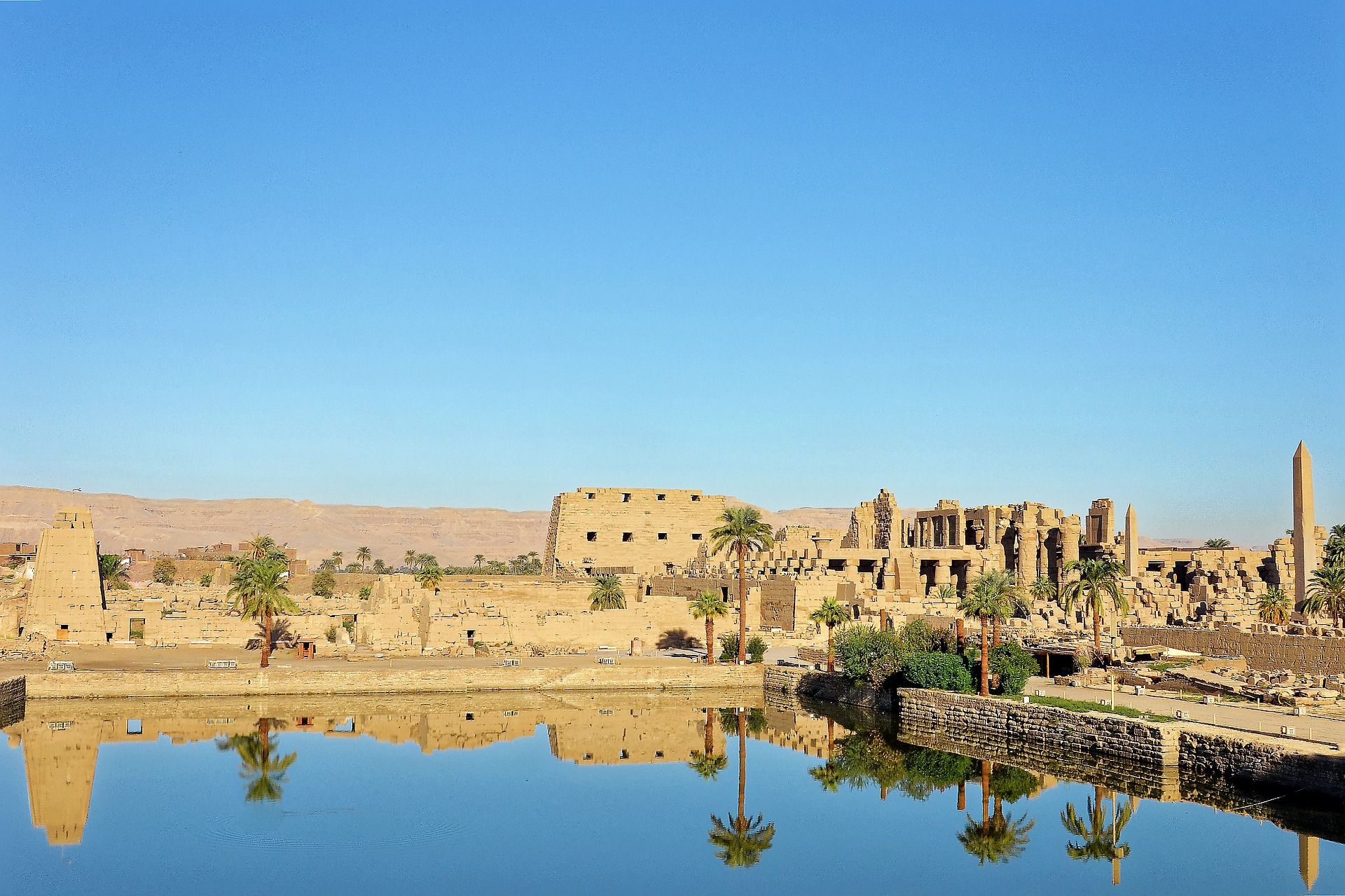
A significant aspect of Aswan’s charm lies in its rich geological offerings. Stretching alongside the tranquil banks of the Nile are vast expanses of golden dunes, interrupted occasionally by granite quarries. These aren’t mere rocky outcrops; they are silent witnesses to the architectural prowess and relentless ambition of ancient Egyptian builders. It is here that the formidable obelisks, which stand tall in various parts of Egypt, were painstakingly carved out and transported, bearing testimony to both human ingenuity and nature’s bounty.
One such marvel, the Unfinished Obelisk, lies in its original quarry, a monument to ambition and the challenges of ancient engineering. Gazing upon this colossal structure, one can almost hear the chisels’ rhythmic echoes and the architects’ deliberations, offering a rare and tangible connection to the craftsmen of yesteryears and their unfinished dreams.
But the magic of Aswan doesn’t stop at its quarries. The Island of Philae emerges from the waters like a mirage, holding secrets and stories that span centuries. Dominating this island are the temples consecrated to the goddess Isis, a deity synonymous with motherhood, magic, and rebirth. The grand pylons, courtyards, and sanctuaries of the Philae temple complex narrate tales of love, loyalty, betrayal, and divine intervention. These stories, set against the mesmerizing backdrop of Lake Nasser, come to life every evening. As the sun dips below the horizon, the temples are illuminated in a symphony of lights and sounds, with narratives in multiple languages resonating across the waters, captivating every onlooker and leaving an indelible impression.
In Aswan, every stone, ripple, and ray of sunlight is imbued with stories, waiting to be discovered, cherished, and retold. It’s not just a city; it’s a living chronicle of times that once were and the harmonious blend of cultures that continue to thrive.
Best Guided Trips to Egypt Abu Simbel: Witness to Sun Gods and Mighty Pharaohs
Perched on the southern frontier of ancient Egypt, near its border with Nubia, the monumental edifices of Abu Simbel stand as enduring symbols of power, faith, and unparalleled architectural brilliance. Rising majestically from the sands, and gazing out onto the vast expanse of Lake Nasser, the twin temples of Abu Simbel are more than just stone structures; they are chronicles of an era when gods walked the earth and pharaohs held the threads of the cosmos.
Commissioned by one of ancient Egypt’s most formidable rulers, Pharaoh Ramses II, these temples weren’t just a display of his might but also of his deep-rooted devotion to the pantheon of Egyptian deities and to himself. Hewn directly from the craggy mountainside, the process of their creation was, undoubtedly, an endeavor of epic proportions. Imagining the ancient artisans, under the scorching sun, chiseling away at the rock to create the intricate carvings, statues, and hieroglyphs, brings to life the sheer determination and vision of the epoch.
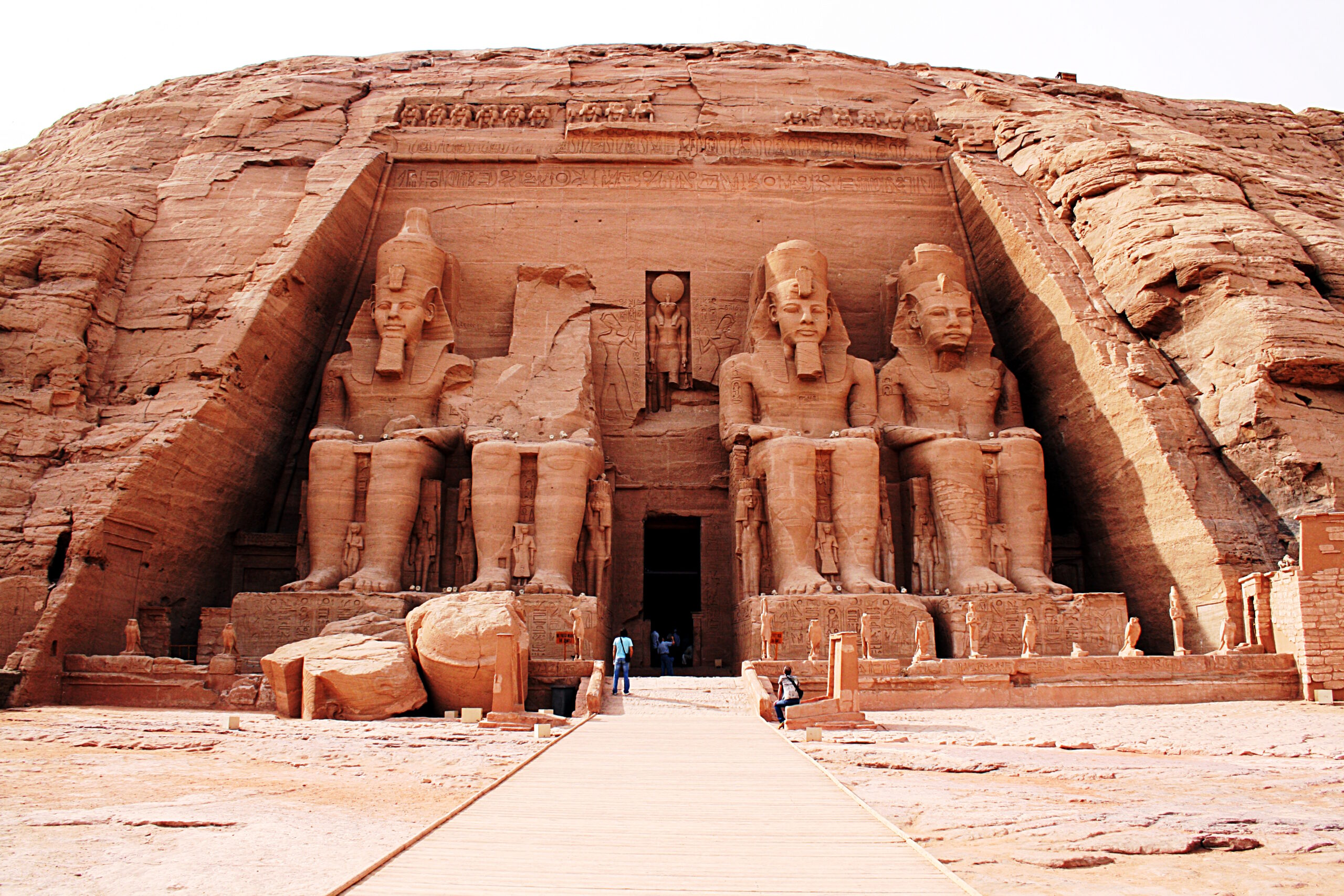
The grand façade of the main temple is guarded by four colossal statues of Ramses II, seated majestically, their faces etched with the calm of divinity and the authority of a ruler. Between their legs and by their sides are smaller figures, representing members of the royal family, underscoring the importance of lineage and dynasty.
However, the true magic of Abu Simbel is revealed in an astronomical marvel—an event that has become a pilgrimage for enthusiasts. Engineered with an astute understanding of the cosmos, the temple’s inner sanctum comes alive twice a year in a mesmerizing play of light and shadow. As the sun rises, its rays penetrate the temple’s corridor to illuminate the statues of Ramses II, Amun-Ra, and Ra-Horakhty, bathing them in a golden glow. This celestial dance, however, intentionally spares the statue of Ptah, the god associated with the underworld and darkness, leaving him enshrouded in shadows. This precise alignment is not just an architectural feat but also a testament to the pharaoh’s claim of divinity and the intricate mesh of religion, royalty, and science in ancient Egypt.
Today, as travelers from across the globe set foot in this sacred enclave, the air is thick with reverence and wonder. The whispers of ancient priests, the footfalls of devout pilgrims, and the silent gaze of the gods merge seamlessly with the gasps of modern-day visitors, reminding us of the timeless allure and undying legacy of Abu Simbel.
Alexandria: The Mediterranean Jewel
With its azure waves gently caressing golden shores, Alexandria is not just a city but a vivid tapestry woven with threads of history, innovation, and natural splendor. Founded in 331 BCE by none other than the legendary conqueror, Alexander the Great, this Mediterranean port city has been the meeting point of empires, cultures, and ideas, cementing its place in the annals of time as a crucible of civilization.
In the heyday of its glory, Alexandria was a lighthouse of knowledge, quite literally and figuratively. The ancient Library of Alexandria wasn’t merely a repository of scrolls; it was the intellectual heart of the world. Philosophers, scholars, poets, and scientists from all corners of the known world flocked here, making it a melting pot of ideas and innovations. While the original library is lost to history, its spirit is resurrected in the form of the Bibliotheca Alexandrina. This modern architectural marvel, with its sleek design and vast resources, is not just a homage to its ancient predecessor but a beacon for the future, fostering learning, creativity, and global dialogue.
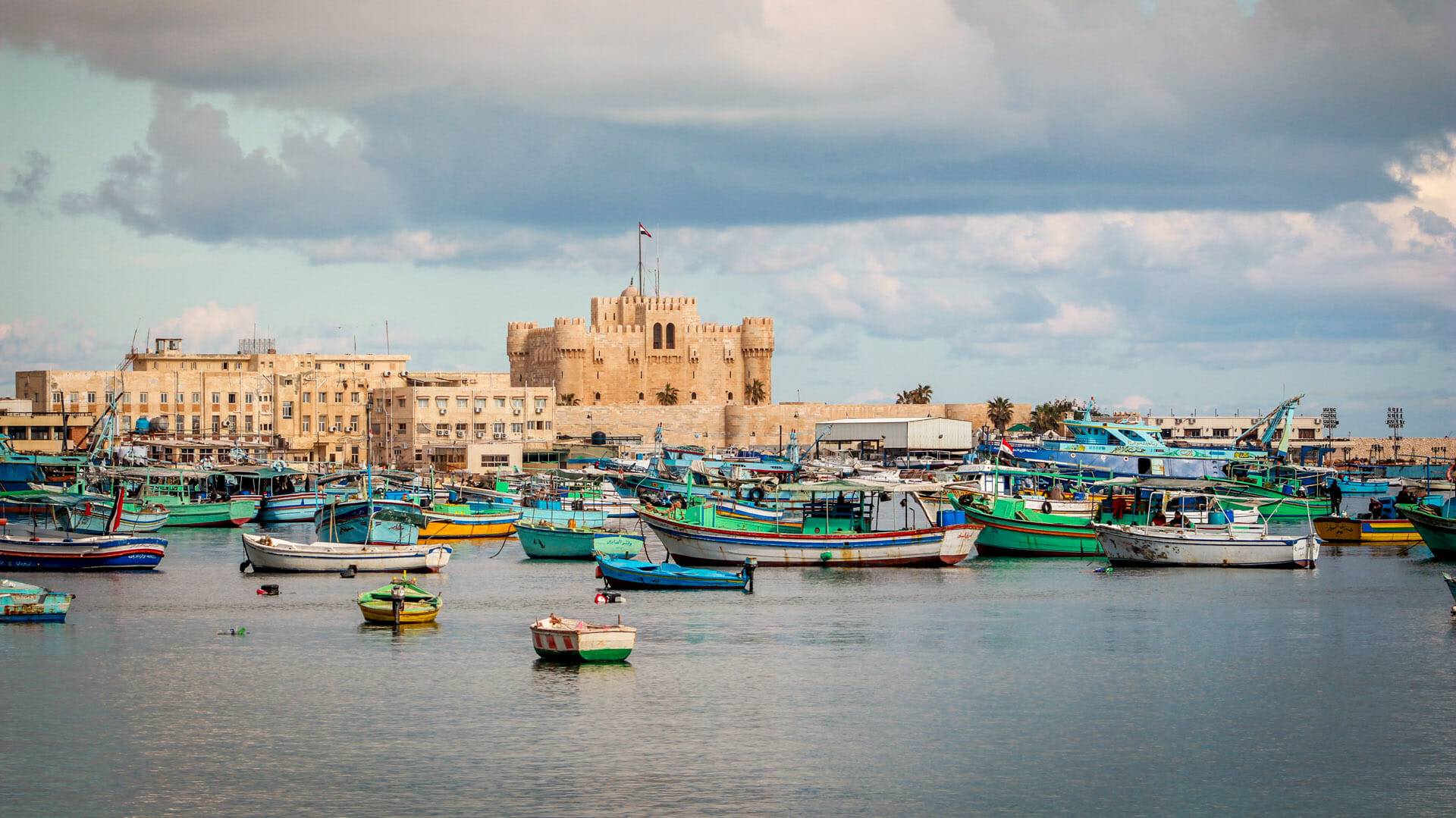
Walking through the streets of Alexandria, one is transported across epochs. The city’s illustrious Greco-Roman heritage is palpable at every turn. The Roman Amphitheatre, with its semi-circular tiers, whispers tales of bygone performances, echoing the cheers and applauses of ancient audiences. Descending into the subterranean world of the Catacombs of Kom El Shoqafa, one encounters a blend of Egyptian, Greek, and Roman funerary art, a testament to the city’s multicultural legacy.
Perched on the eastern tip of the city, looking out to the vast expanse of the Mediterranean, stands the Qaitbay Citadel. This 15th-century fortress, with its robust walls and sentinel towers, is a symbol of Alexandria’s enduring strategic importance. But what makes this citadel even more special is its foundation upon the ruins of the legendary Lighthouse of Alexandria, or the Pharos, one of the Seven Wonders of the Ancient World. As the sun sets, casting a golden hue over the waters, one can almost envision the ancient lighthouse guiding ships with its radiant beacon.
Alexandria is more than just a destination; it’s an experience. It invites you to wander through its lanes, to get lost in its stories, and to be swept away by its charm. It’s where the past and present converse, where myths come alive, and where every traveler finds a story waiting to be discovered.
Conclusion:
From the bustling streets of Cairo to the tranquil Nile in Aswan, Egypt is a mosaic of ancient tales, timeless artifacts, and modern dynamism. As you embark on this journey, remember that each city, monument, and artifact tells a story. Listen closely, and you’ll hear the whispers of a civilization that once was, and that continues to enchant and inspire to this day. Welcome to Egypt – where every grain of sand has a story to tell.

